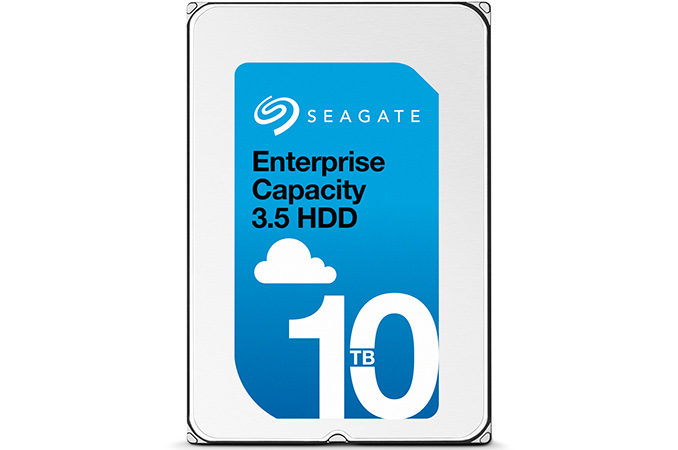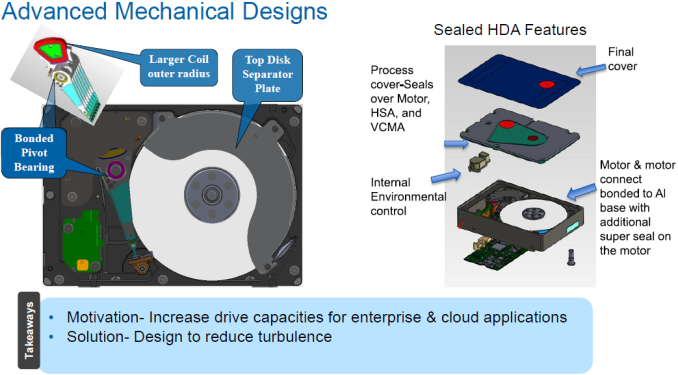Seagate Begins Volume Shipments of Helium-Filled HDDs, Reveals Their Final Specs
by Anton Shilov on April 28, 2016 4:00 PM EST- Posted in
- HDDs
- Seagate
- Helium HDD
- Enterprise Capacity
- 10 TB

Seagate has started volume shipments of its first helium-filled hard drives. They were announced earlier this year. The new HDDs are available to all interested parties, which means that Seagate’s biggest customers have already evaluated and validated them. Volume shipments of the 8 TB and 10 TB helium-filled hard drives will help Seagate to improve its financial results and margins, since the new HDDs will be amongst the most expensive drives in the company’s lineup.
Brand New Platform
The Seagate Enterprise Capacity 3.5 helium-filled hard drive is based on the company’s brand-new hermetically-sealed platform featuring fourteen heads and seven perpendicular magnetic recording (PMR) platters with up to 1.43 TB capacity each. Seagate claims that the new HDD platform is based on a special wide-weld hermetically sealed drive enclosure with a design based on a multi-step forging process. Besides that, it uses a motor attached to both top and bottom covers, in order to better handle vibrations and maximize reliability. Sensors for humidity, temperature and helium pressure ensure that the helium-filled drive is always being monitored for reliable operation.
Seagate has incorporated PowerChoice and PowerBalance technologies in the new drives. PowerChoice helps datacenter operators to manage power consumption during idle time by either reducing spindle speed, or even stopping disks completely, after an admin-defined interval of idle time. Meanwhile, PowerBalance technology helps the administrators to balance the power consumption and IOPS (input/output operations per second) performance of hard drives prior to installation.
The Enterprise Capacity 3.5" helium hard drive sports a 256 MB multi-segmented cache. The platters rotate at 7200 revolutions per minute (RPM). The host interface is SATA 3.2 (6 Gbps), and supports hot-plugging.
Seagate claims that its multi-segmented cache helps the Enterprise Capacity 3.5 (Helium) HDD to improve performance compared to its predecessors and rivals and enables burst transfer rates at up to 600 MB/s (for small chunks of data, of course). The company does not reveal many details about its new caching algorithms, but 256 MB of memory is still a rather huge buffer.
Lineup and Performance Numbers
Seagate will offer multiple versions of its Enterprise Capacity 3.5" Helium HDDs, including models with 8 TB capacity, 4K and 512e sectors as well as self-encrypting (SED) options.
| Lineup of Seagate's Enterprise Capacity 3.5" Helium HDDs with SATA Interface | |||||||
| Standard 4KN | Standard 512e | Self-Encrypting 4KN (SED) | Self-Encrypting 512e (SED) | ||||
| 10 TB Capacity | ST10000NM0006 | ST10000NM0016 | ST10000NM0056 | ST10000NM0046 | |||
| 8 TB Capacity | ST8000NM0006 | ST8000NM0016 | ST8000NM0056 | ST8000NM0046 | |||
Seagate declares fairly high performance numbers for its Enterprise Capacity 3.5" Helium HDDs: 243 or 254 MB/s maximum sustained transfer rate as well as 4.16 ms average latency, which is higher than the numbers listed by competing drives from HGST and Western Digital.
| Comparison of Helium-Filled HDDs | ||||||
| Seagate Enterpise Capacity ST10000NM0006 |
HGST Ultrastar He10 HUH721010ALE600xxxx |
WD Gold WD8002FRYZ |
||||
| Capacity | 10 TB | 8 TB | ||||
| RPM | 7200 RPM | |||||
| Interface | SATA 6 Gbps | |||||
| DRAM Cache | 256 MB | 128 MB | ||||
| Maximum Sustained Transfer Rate | 243 MB/s 254 MB/s |
225 MB/s 249 MB/s |
205 MB/s | |||
| Average Latency | 4.16 ms | unknown | ||||
| Rated Workload (Drive Writes Per Day) | 0.189 | unknown | 0.189 | |||
| Equivalent of 550 TB of Writes per Year | unknown | Equivalent of 550 TB of Writes per Year | ||||
| Acoustics | Idle | 28 - 30 dBA | 20 - 36 dBA | 20 dBA | ||
| Seek | 32 - 34 dBA | unknown | 36 dBA | |||
| Power Rating | Idle | 4.5 W | 5 W | 5.10 W | ||
| Random Write | 6.5 W | 6.8 W | 7.4 W | |||
| Random Read | 8.5W | 6.8 W | 7.4 W | |||
| MTBF | 2.5 million hours | |||||
| Warranty | 5 Years | |||||
| Price | $695 at Amazon | unknown | $629 | |||
Usage of helium inside a hard drive helps to reduce the drag force acting on the spinning disk stack and lower the fluid flow forces affecting the disks and the heads. As a result, HDD makers can install up to seven platters into a standard drive and also use lower-power motors and mechanics. This reduces the power consumption of the HDDs. For example, power consumption of Seagate’s 10 TB hard drive is actually lower than power consumption of the company’s 8 TB drive for nearline applications (8.5 W per drive vs. 10.4 W per drive).
For cloud datacenters, power consumption of HDDs is as important as their capacity. Increasing the capacity of the top-of-the-range hard drives from 8 TB to 10 TB automatically boosts total capacity per rack by 25% (which means an increase from 1920 TB to 2400 TB per standard rack that holds 240 drives). Going helium additionally reduces the power consumption of such a rack by up to 456 W. An increase of storage capacity amid reduction of power consumption not only maximizes data storage capacities of a particular facility, but also shrinks its total cost of ownership (TCO), an important metric for companies with multiple large datacenters.
Broad Availability, But No SAS Models Yet
It should be noted that when Seagate introduced its Enterprise Capacity 3.5" 10 TB HDD in January, the company announced models with Serial ATA 6 Gb/s and SAS 12 Gb/s interfaces, which were aimed at different environments. At present, Seagate only ships models with SATA interfaces, meaning that customers, who need SAS, may still be evaluating SAS drives, which will come to market later. By contrast, HGST offers different models of its 10 TB HDDs: with SATA and SAS interfaces.
While Seagate said that its 10 TB helium-filled HDDs are available from its distributors worldwide, it did not reveal their actual prices. Amazon currently sells the Seagate Enterprise Capacity 3.5" HDD 10TB (ST10000NM0016) for $695.98 (note that this is not an MSRP), which is far from affordable. Still, keep in mind that we talking about exclusive products based on a brand-new platform. Such HDDs make a lot of sense for datacenters, but, currently, not so much for desktops or NAS units.
Source: Seagate











65 Comments
View All Comments
FunBunny2 - Friday, April 29, 2016 - link
-- Air cushioning of the heads have been a known fact for as long as winchester-based DASD has existed.longer actually. IIRC, the first DASD from IBM mainframes exploited "floating heads", at least the 1301 drive. that was 1961:
"The 1301 is the first disk drive to use heads that are aerodynamically designed to fly over the surface of the disk on a thin layer of air."
here: https://en.wikipedia.org/wiki/History_of_IBM_magne...
Kalessian - Friday, April 29, 2016 - link
I personally don't think the things he said warranted this kind of attitudedueckadam - Saturday, April 30, 2016 - link
I really don't see what he's doing so wrong. He has some knowledge that makes him think one thing, and he's presented with information that conflicts with that, and he's trying to reconcile the two. Really, the conclusions he's drawing do seem reasonable, even if they're incorrect.As far as googling it, it's not as easy as it sounds. Sure, it's easy to find stuff saying that the head rides on a cushion of air, but I wasn't able to find much explaining the phenomenon, i.e. the mechanism by which the air bearing forms or how it acts as a cushion. So if you're as knowledgeable about engineering and physics as the condescending tone of your post implies, would you care to try and explain, or provide a source that does?
Solandri - Monday, May 2, 2016 - link
He's not spouting pseudo-science. What he's describing is exactly what happens with an incompressible fluid like water. It's why ships need tugboats to push them away from docks - they can't do it under their own power (unless they have a bow thruster), since any forward or backwards movement just pushes them closer to the dock. The QE2 ran aground partly due to this effect (high speed over shallow water caused it to be "sucked" down by Bernoulli forces).https://en.wikipedia.org/wiki/Squat_effect
Air (and helium) however are compressible, which leads to a different phenomenon (ground effect) which counters Bernoulli.
sor - Thursday, April 28, 2016 - link
You forget what would be causing the gas to move at all:the platter. The gas is actually caught by the platter as it spins, sucking it under the heads.If you lay a piece of paper on a table, lift one side, and try to blow under it, it won't magically stick harder to the table. Yes, there is air moving, but you can't overcome displacement. The pressure is actually higher as it is being compressed/forced, and the movement is alleviating the pressure.
sor - Thursday, April 28, 2016 - link
Sucking is probably a bad way to describe it... The platter actually pushes the air it contacts, which increases pressure under the heads and creates the cushion.BurntMyBacon - Monday, May 2, 2016 - link
@sor: "The platter actually pushes the air it contacts, which increases pressure under the heads and creates the cushion."Which is possible because air/helium is compressible. In fact, it is this compressibility that stabilizes the heads. It makes it act as a shock absorber of sorts.
@Solandri: " What he's describing is exactly what happens with an incompressible fluid like water. ... Air (and helium) however are compressible, which leads to a different phenomenon (ground effect) which counters Bernoulli."
This. The Bernoulli effect doesn't disappear, it simply ceases to be the dominant force. Interestingly, IIRC, it actually helps dampen vibrations by resisting the repulsing part of the vibration.
MrSpadge - Friday, April 29, 2016 - link
As far as I know you're correct - the only piece missing is that the heads are indeed aerodynamically designed to provide the proper force repelling them from the platter. That's what Azethoth described in fancy scientific language ("riding the cushion of air").freeskier93 - Saturday, April 30, 2016 - link
Your critical flaw is the misguided use of Bernoulli's principal. Bernoulli's principal is actually derived from Navier-Stokes through certain assumptions, which are not applicable here. What we're actually looking at in the case of spinning platters is a Couette flow, where a velocity is created through shear forces in the fluid and NOT a pressure gradient. There is no pressure gradient in the tangential direction.Solandri - Monday, May 2, 2016 - link
That's a pretty good recollection of physics - just enough to get you into trouble. What you're describing happens if the fluid is a liquid. We ran into it all the time with our robot submersibles - if you get too close while running parallel to a wall, the submersible gets "sucked" against it by Bernoulli forces and you're stuck (need to turn so a thruster can push you away... if you have enough room to turn).It's different when the fluid is a gas. At moderate distances, Bernoulli rules. But as the two surfaces get very close, the compression of the gas as it squeezes between the head and platter overpowers Bernoulli, and you get a high pressure zone. In aircraft, it's called ground effect, and can be used to greatly extend cruising range because the higher pressure between the wing and ground (or water) creates more lift, reducing drag.